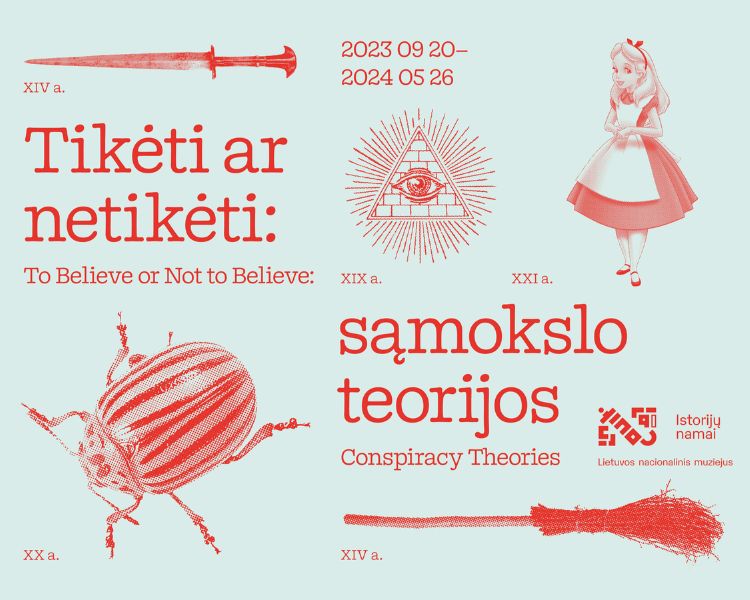To Believe or Not to Believe: Conspiracy Theories

With the advancement of technology and the arrival of the Internet, conspiracy theories have spread exponentially around the world. But since the Middle Ages, many subjects have been ensnared by conspiracy theories: the Jewish people, witches and warlocks, and somewhat later, since the 20th century, the Holocaust, the Cold War period, the events of 11 September 2001, the COVID-19 pandemic, and climate change. There are hundreds of conspiracy theories – it would be impossible to name them all. But have you ever wondered about the origins of these theories? Some we know already, others we are just beginning to recognize. Some were only around for a brief period of time and we know of them from textbooks or our grandparents’ stories, but others are ageless or only now taking shape.
This international exhibition, “To Believe or Not to Believe: Conspiracy Theories”, reveals the intriguing world of conspiracy theories, where the boundary between reality and fiction often vanishes, and invites you to return to the past and explore how and why certain conspiracy theories came about.
In the Middle Ages, for example, persecution was not reserved just for witches and warlocks – some social and ethnic groups were blamed for unbelievable things. But did you know that the last Salem witch was exonerated in the United States only in 2022? A theory created in the Middle Ages about people engaged in witchcraft and their secret pact with the devil affected entire communities around the world, leading to the persecution of women.
The Judeophobia stoked from the Middle Ages onward encouraged the belief that Jews were supposedly harming Christians: first by poisoning water wells and engaging in ritual murders, and later through economic crises and a campaign to rule the world, and sometimes even by blaming all disasters and misfortunes on one person – George Soros, a well-known name in Lithuania. Even in the context of contemporary conspiracy theories, old unproven tropes are being revisited: from charges of ritual murder and the desecration of the Eucharist to a supposed secret plan to rule the world through a global pandemic.
This exhibition explores all the most significant historical phases: the aforementioned Middle Ages, the Enlightenment period, when Freemasons and Illuminati were accused of starting the French Revolution, and a presentation of the primary sources “thanks” to which a conspiracy could spread like a virus. We also explore the most brutal dictatorships of the 20th century, showing how conspiracy theories born in previous eras became a tool for manipulating society, leading to one of the greatest human tragedies – the mass extermination of those deemed to be “enemies of the state” of totalitarian systems. Perhaps more than ever before, the Cold War period taught societies to trust nothing and fear everything – from the threat of the atomic bomb to Colorado potato beetles. Turbulent times – wars, historical upheavals, revolutions – have always been conductive to the spread of conspiracy theories. As a result, 21st century humanity, influenced by a growing number of conspiracy theories, no longer trusts anything or anyone: neither official governments nor medicine, not the scientists speaking out with greater urgency about climate change, and not the technologies that bring them beneficial progress.
This is the third interpretation of this exhibition. It was first conceived and mounted by the Stiftung Kloster Dalheim LWL-Landesmuseum für Klosterkultur (Dalheim Monastery Foundation – LWL State Museum of Monastic Culture) in Lichtenau, Germany. The exhibition’s enormous success encouraged the Luxembourg City History Museum to create an adapted version, adding a unique local and relevant perspective. This time, we invite you to join the journey at the Lithuanian National Museum’s House of Histories, where you will learn not only about the best known and notorious conspiracy theories, but also about their origins and the clear evidence that deconstructs them. This exhibition seeks not only to raise awareness, but also to encourage critical thinking and build resistance to propaganda and conspiracy theories themselves.\
This exhibition has been curated by Dr. Ina Ėmužienė and Dr. Milda Kvizikevičiūtė. The exhibition in Lithuania was conceived by Dr. Rūta Kačkutė, General Director of the National Museum of Lithuania.
Tuesday 10:00-18:00
Wednesday 10:00-20:00
Thursday 10:00-18:00
Friday 10:00-18:00
Saturday 10:00-18:00
Sunday 10:00-18:00
For schoolchildren, students, seniors: 3.50 Eur
- Contacts
Vilnius Tourist Information Centre Pilies g. 7, Vilnius, +370 5 262 9660 [email protected]
- Usefull Information
- Announce Your Event
- How to Publish an Event
- Responsibility Limitation
